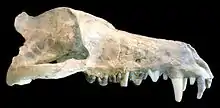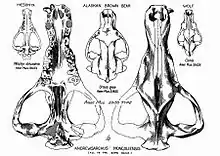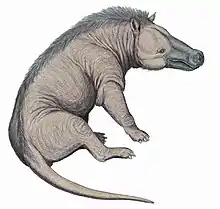Andrewsarchus
Andrewsarchus (/ˌændruːˈsɑːrkəs/) is an extinct genus of mammal that lived during the middle Eocene epoch in what is now Inner Mongolia, China. Only one species is usually recognized, A. mongoliensis, known from a single skull of great size discovered in 1923 during the expeditions to central Asia by the American Museum of Natural History (AMNH). Generally classified as a mesonychid since its original description, most recent studies classify it as an artiodactyl. One study specifically classifies Andrewsarchus as a member of the clade Cetancodontamorpha, closely related to entelodonts, hippos and cetaceans (members of the infraorder that includes the whales).
| Andrewsarchus | |
|---|---|
 | |
| Holotype skull at the American Museum of Natural History | |
| Scientific classification | |
| Kingdom: | Animalia |
| Phylum: | Chordata |
| Class: | Mammalia |
| Order: | Artiodactyla |
| Clade: | Cetancodontamorpha |
| Genus: | †Andrewsarchus Osborn, 1924 |
| Type species | |
| †Andrewsarchus mongoliensis Osborn, 1924 | |
| Synonyms | |
| |
Taxonomy

The only known skull was found at a locality in the lower levels of the middle Eocene Irdin Manha Formation of Inner Mongolia,[1][2] by the paleontological assistant Kan Chuen Pao during the spring of the second year (1923) of the Central Asiatic Expeditions (CAE) of the AMNH, led by the explorer and naturalist Roy Chapman Andrews. The skull is now on display at the American Museum of Natural History in New York.[3]
The genus name was dedicated to Andrews by Henry Fairfield Osborn, and it derives from the surname "Andrews" + Ancient Greek: ἀρχός archos ('leader', 'chief' or 'commander'). The species epithet mongoliensis refers to Inner Mongolia, the region where the type material was found.[1]
It was classified in the clade Mesonychia due to the similarity in structure between its teeth and skull with those of other mesonychid species known from complete skeletons; however, much of this was based only on Osborn's original publication, and more recent studies have found it to have no special mesonychid affinities, instead grouping it with various artiodactyl clades. Indeed, one study (Spaulding et al.) has not only found them to be closer to entelodonts, but as kin to Whippomorpha in the clade Cetacodontamorpha.[4]
Description
Osborn (1924) declared Andrewsarchus as the largest terrestrial mammalian carnivore known on the basis of the length of the skull, which he used to estimate its size by comparing it to the mesonychid Mesonyx.[1] However, since the known morphology of Andrewsarchus is entelodont-like and consequently very different to mesonychids in habits and likely in body proportions, according to Szalay and Gould (1966) if a size estimate has to be made it would be more appropriate to follow the proportions of entelodonts.[5]
The type skull of Andrewsarchus mongoliensis (AMNH 20135) is 83.4 cm (32.8 in) in basal length,[1] with a long snout comprising 60% of that measurement. The orbits of the eyes are set low and widely separated from one another by the snout, the sagittal crest is small, and the articulation for the mandible is shallow.
Andrewsarchus mongoliensis has a complete placental tooth formula with 3 incisors, 1 canine, 4 premolars and 3 molars in each side of the jaws, as in entelodonts. The incisors are arranged in a semicircular configuration, the second and third premolars are elongated and single-cusped, the crowns of the molars are heavily wrinkled, and the first and second molars are much more heavily worn than the precedent and subsequent teeth. In fact, the molars are so similar to those of entelodonts it has been suggested that had they been found in isolation, they would have been classified as such.[5] There are also greatly enlarged second incisors, as big as the canines, which despite not being preserved can be estimated from the diameter of their tooth sockets. They were proportionally small compared to the whole dentition and the size of the skull according to Szalay and Gould, contrary to Osborn's description.[5]
References
- Osborn, H. F. (11 November 1924). "Andrewsarchus, giant mesonychid of Mongolia" (PDF). American Museum Novitates. American Museum of Natural History (146). Archived from the original on 2020-11-02.
- Wang, YuanQing; Meng, Jin; Beard, Christopher K.; Li, Qian; Ni, XiJun; Gebo, Daniel L.; Bai, Bin; Jin, Xun; Li, Ping (3 November 2010). "Early Paleogene stratigraphic sequences, mammalian evolution and its response to environmental changes in Erlian Basin, Inner Mongolia, China". Science China Earth Sciences. 53 (12): 1918–1926. Bibcode:2010ScChD..53.1918W. doi:10.1007/s11430-010-4095-8. S2CID 129645513.
- AMNH (3 July 2013). "Andrewsarchus, "Superb Skull of a Gigantic Beast"". American Museum of Natural History. Archived from the original on 2015-10-15. Retrieved 18 February 2014.
- Spaulding, Michelle; O'Leary, Maureen A.; Gatesy, John (23 September 2009). "Relationships of Cetacea (Artiodactyla) Among Mammals: Increased Taxon Sampling Alters Interpretations of Key Fossils and Character Evolution". PLOS ONE. 4 (9): e7062. Bibcode:2009PLoSO...4.7062S. doi:10.1371/journal.pone.0007062. PMC 2740860. PMID 19774069.
- Szalay, Frederick S.; Gould, Stephen Jay (1966). "Asiatic Mesonychidae (Mammalia, Condylarthra)". Bulletin of the American Museum of Natural History. 132: 127–174. hdl:2246/1112.
| Wikimedia Commons has media related to Andrewsarchus. |
